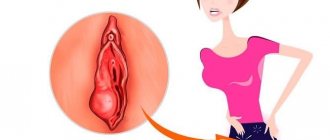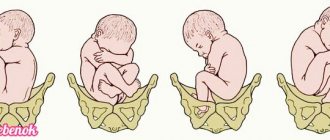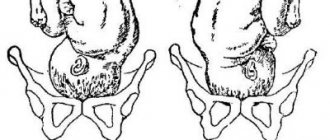In his book “Caesarean section: a safe option or a threat to the future?” renowned obstetrician Michel Oden analyzes the absolute and relative indications for caesarean section. Relative ones most often depend on the doctors delivering the baby and the current situation in obstetrics. And their number is growing all the time...
Many women whose babies are about to be born will be offered a caesarean section. If we undertake to analyze all possible situations, the information will fill volumes. There are several ways to classify the reasons for the “upstream” birth. We will try to separate absolute and relative indications for surgery.
Absolute maternal and fetal indications
Mandatory indications identified in a woman in labor:
- anatomically narrowed pelvis;
- early placental abruption in a normal location;
- complete placenta previa;
- bleeding with incomplete presentation;
- severe gestosis and eclampsia, renal failure;
- scarring of the tissues of the pelvis, vagina, walls of the uterus, cervix, tumor neoplasms of the pelvic organs, fistulas of the genital organs and intestines.
From the fetus:
- transverse, oblique, pelvic presentation;
- incorrect entry of the head into the birth canal;
- umbilical cord prolapse;
- acute oxygen starvation;
- near-death condition or death of a woman in labor.
Caesarean section: pros and cons
If a woman has the opportunity to think about the need for a cesarean section and make a decision on her own (but, of course, based on the recommendations of the attending physician), it is worth carefully weighing the pros and cons. The arguments in favor are the impossibility of genital injuries and ruptures during surgery and rapid delivery. Among the disadvantages, women cite the lack of psychological connection with the child, pain at the suture sites, limitation of motor activity and the need for special care after surgery, and a scar.
The consequences after cesarean section are also quite serious. This includes the psychological state of the mother, pain, a scar on the abdomen, the inability to take a bath and resume sexual relations for several months, and restrictions on physical activity. There are consequences for the child as well. It is possible that amniotic fluid will remain in the baby’s respiratory tract and anesthesia drugs will enter his bloodstream. They also talk about psychological consequences. It is generally accepted that children who are born by caesarean section adapt less well to environmental conditions.
Relative indications from mother and fetus
On the part of the pregnant woman:
- clinically narrowed pelvis;
- gestosis, which continues from the 20th week of pregnancy and is difficult to treat;
- extragenital diseases, which during natural delivery will lead to a significant deterioration in health;
- weak labor, pathologically occurring labor process;
- congenital pathologies of the genital organs;
- post-term pregnancy;
- age over 30, especially for those giving birth for the first time.
From the fetus:
- chronic poor circulation between the fetus and the placenta;
- early release of water in breech presentation or primigravida over 30 years of age;
- weight more than 4 kg.
Indications for cesarean section based on vision refer to relative indications on the part of the mother:
- fundus dystrophy;
- eye injury;
- undergone surgery due to retinal detachment;
- myopia;
- severe myopia of minus seven diopters or more.
Indications for caesarean section by age are also relative. Depends on the general condition of the woman in labor and the course of pregnancy.
What indications for caesarean section are considered relative?
Relative indications include situations in which the circumstances that arose during pregnancy are taken into account. The cesarean birth rate is increasing precisely because of relative indications, because theoretically a woman should be able to cope with natural childbirth, but doctors play it safe and prescribe a planned procedure so that there is no risk of having to undergo an emergency operation during the birth process.
In cases where there is a choice between a cesarean section and a natural birth, the gynecologist relies on relative indications. And they can be as follows:
- Post-maturity. When the baby “lingers” inside and does not want to be born before the specified date, then he is helped through surgical intervention.
- Large fruit. It is generally accepted that a fruit weighing over 4 kg is large. But here individual physical characteristics should be taken into account. Many women with a wide pelvis (namely the pelvis, not the butt) have no problems giving birth to heroes weighing more than 4 kg. If nature has not given the woman a wide pelvis, then a caesarean section is the solution for a large pregnancy.
- Multiple pregnancy. In most cases, this operation is due to the location of the children. The majority of twins settle in the mother’s belly by week 32 in position 69 (head and legs). A natural birth is possible if the baby goes first, lying head down, and the second takes the “correct” position for childbirth with a lower presentation. Still, doctors do not take risks and resort to cesarean section during multiple pregnancies.
- A clear manifestation of varicose veins on the legs. When pushing, the pressure increases significantly, which causes a risk of damage to the peripheral veins and, as a result, severe bleeding.
- Divergence of the symphysis. If the discrepancy of the symphysis pubis is more than 10 mm (this happens long before the onset of labor), then the woman is prescribed bed rest and elective surgery if the fetus weighs more than 3.5 kg. Such measures are taken to prevent complete rupture of the symphysis pubis during the birth process.
Indications for emergency surgery
Caesarean sections are usually planned in advance. But sometimes situations arise in which emergency intervention is the only way to save the life of the mother and baby.
This is an operation for life-saving reasons:
- the head is too large for the pelvis, detection of pathology during childbirth;
- early discharge of amniotic fluid in the absence of labor;
- weak labor uterus even after induction of labor;
- placental abruption during childbirth;
- the threat of uterine rupture or the beginning of a rupture - with such an injury severe bleeding occurs;
- loss of umbilical cord loops and blocking of their head;
- fetal hypoxia, threatening its death;
- gestosis of a pregnant woman, emerging renal failure.
Abdominal delivery: absolute indications
Maternal factors that, if present, cannot be avoided without a cesarean section include:
Anatomically narrow pelvis (the degree of narrowing is taken into account, that is, 3 - 4, in which the true conjugate is 9 cm or less)
The narrow pelvis is divided into 2 groups according to the shape of the narrowing.
- The first group includes: a transversely narrowed pelvis, a flat pelvis (a simple flat pelvis, a flat-rachitic pelvis and a pelvis with a decrease in the wide part of the cavity), and, of course, a generally uniformly narrowed pelvis. These are quite common forms of pelvic contractions.
- The second group (rare forms) includes an oblique pelvis, a constricted pelvis, pelvic deformation due to bone exostoses, bone tumors or due to fractures, a kyphotic pelvis, a funnel-shaped pelvis and other types of narrow pelvises.
An anatomically narrow pelvis with degree 3 or 4 can complicate the course of labor. During labor, almost 40% of women in labor experience:
- weakness of uterine contractions (contractions)
- early rupture of water
- possible prolapse of the umbilical cord or fetal arms/legs
- development of chorioamnionitis, endometritis and infection of the unborn baby
- as well as intrauterine fetal hypoxia
During the pushing period, the following complications may appear:
- secondary weakness of pushing
- intrauterine hypoxia of a child
- birth injury
- uterine rupture
- tissue necrosis with the formation of genitourinary fistulas, entero-genital fistulas
- injury to the pelvic joints and nerve plexuses
- and if childbirth reaches the third period, then subsequent and/or postpartum bleeding cannot be avoided.
Complete placenta previa
As you know, the placenta is the organ that communicates between the organisms of mother and child. In a normal pregnancy, the placenta is located either in the fundus of the uterus, or along the anterior or posterior wall. If the placenta is located in the lower segment of the fetal sac, and completely covers the internal pharynx, then it becomes clear that the child’s exit from the mother’s womb naturally becomes impossible. Moreover, complete placenta previa poses a potential threat not only to the unborn baby, but also to his mother throughout the entire period of pregnancy, because bleeding can occur at any moment, the intensity and duration of which cannot be predicted.
Case study : I saw a 38-year-old woman from the very beginning of her pregnancy. This was not the first pregnancy, but it was very welcome. Despite the absence of any aggravating circumstances in her medical history, her placenta formed in the lower third of the uterus and blocked the internal os (complete presentation). The woman spent almost the entire pregnancy on sick leave, under the supervision of doctors, and did not experience a single bleeding. She successfully progressed to 37 weeks and was admitted to the pathology ward in preparation for a planned caesarean section. Well, as usual, for some reason (or maybe fortunately) her bleeding began in the hospital and on a day off. Of course, we immediately went for an immediate caesarean section; there was no time to waste. This is how a planned operation turned into an emergency - the child was born healthy and of normal weight.
Incomplete placenta previa with severe bleeding
Incomplete placenta previa is said to occur when the placenta only partially covers the internal os. There are regional and lateral presentations.
- When the placenta is located marginally, it only slightly affects the internal os
- Whereas with the side it overlaps by half or 2/3 of the diameter.
Incomplete placenta previa also threatens sudden bleeding, the severity of which is difficult to predict. The peculiarity of this localization of the placenta is interesting in that bloody discharge more often appears during labor, because it is at this time that the internal os opens and the placenta gradually exfoliates. The indication for urgent surgery in case of incomplete presentation is massive blood loss, which poses a danger to the life and health of the mother and child.
Premature abruption of a normally located placenta
The placenta can detach either while you are expecting your baby or during labor (usually). The danger of this condition also lies in the occurrence of bleeding, which can be external (that is, visible) - there is bloody discharge from the vagina, internal or hidden (blood accumulates between the placenta and the uterine wall, forming a retroplacental hematoma), and mixed (there is both visible and hidden bleeding) Depending on the area of placental abruption, there are 3 degrees of severity: with moderate and, of course, severe degrees, it is necessary to give birth to the woman in labor as soon as possible, otherwise you can lose not only the baby, but also the mother.
Impending or incipient uterine rupture
There are a great many reasons leading to the threat of uterine rupture. This may be improper management of labor, incoordination of labor forces, large size of the fetus, and much more. In the absence of timely treatment (massive tocolysis, that is, stopping uterine contractions), the threat or beginning of a rupture will very quickly turn into an accomplished, that is, a completed rupture, and both “participants” of the birth, the woman and the unborn child, will die.
Incompetent scar on the uterus
A suture on the uterine wall occurs not only after abdominal delivery, but also after other gynecological operations (for example, conservative myomectomy). The fullness of the scar is determined by ultrasound, and the thickness of the scar-changed surface should reach 3 mm or more, the contours of the scar are even in the absence of connective tissue. If there was a complicated course in the postoperative period (for example, fever, endometritis or long healing of skin sutures) in the anamnesis, this indicates an inferior scar.
Two or more scars on the uterus
If you have a history of two or more cesarean sections, there is no question of independent delivery, since this condition of the uterus significantly increases the risk of rupture along the scar.
Severe forms of gestosis in the absence of a positive effect from therapy and unprepared birth canal
Eclampsia (convulsive attack) can be fatal for a woman and her child (see gestosis during pregnancy). Therefore, this condition requires immediate relief from the burden. Exactly 2 hours are allotted for the treatment of preeclampsia (preconvulsive stage); if there is no effect, immediate surgery is started. Severe and moderate nephropathy should be treated for no more than two weeks, after which the issue of surgery is decided.
Severe extragenital diseases
The list of indications for surgery includes:
- heart disease in the stage of decompensation
- pathology of the nervous system
- severe thyroid disease
- diabetes
- hypertension and much more
Caesarean section for vision is performed in cases of myopia of the 3rd degree (6 or more), complicated myopia, vision surgery, etc. In case of poor vision, it is necessary to exclude the period of pushing, since significant physical activity can lead to retinal detachment and blindness of the woman.
Anomalies of the structure of the uterus and vagina
In the presence of these defects, the contractile activity of the uterus is disrupted, and the fetus is not able to independently pass through the birth canal during childbirth.
- Tumors of the cervix, ovaries and other pelvic organs
- Such tumors close the birth canal and create an obstacle to the birth of the child.
- Extragenital cancer and malignant tumor of the cervix
- Age-related primigravida
Indications for cesarean section based on age (over 30 years) must be combined with obstetric pathology and extragenital diseases. In older primigravidas, the elasticity of the muscles of the vagina and pelvic floor is reduced, so there is a high risk of perineal ruptures. In addition, such women in labor often develop abnormalities of labor forces that are not relieved by therapy.
Fetal factors requiring surgical delivery:
- Malposition
In a normal pregnancy, the fetus should be positioned longitudinally, with the head towards the pelvis. The incorrect position of the unborn child is indicated when he lies obliquely, transversely, or the pelvic end is presented. Caesarean section for breech presentation is performed when the baby weighs more than 3600 g. or less than 1500 grams, as well as with a male fetus (compression of the testicles during birth of the pelvic end can cause infertility in a boy). Breech presentation (legs, pelvic end present) requires surgery, because the baby's head is larger than the pelvic end, and at the birth of the latter, the birth canal is not widened enough for unhindered advancement and birth of the head.
Case study: A woman was admitted to the maternity ward at night with strong contractions. This was her third birth, but she never had an ultrasound scan during the entire pregnancy. During a vaginal examination, I found that the legs were present, the opening of the cervical canal was 5 cm, and this was an absolute indication for delivery through surgery. When I cut the uterus and removed the fetus, I was stunned - the fetus was anencephalic with spina bifida in the cervical region (congenital deformity). Of course, he died immediately after cutting the umbilical cord. On the one hand, surgery for such a developmental anomaly is contraindicated, but on the other hand, who knew if the woman was not examined?
- Acute fetal hypoxia
This condition means that the child suffers in utero, there is not enough oxygen supplied to him, and each contraction aggravates hypoxia. There is only one treatment - immediate delivery.
Case Study : This was my first solo C-section since my internship. I spent the whole night working with a first-time mother, and in the morning I heard with my ear that the child was suffering - the heartbeat was slow and muffled, bradycardia. But we didn’t have a CTG (cardiotocograph) yet, so there was nothing to check it with. I went for the operation at my own peril and risk. And just in time, because she pulled out a child who didn’t even squeak or move his arms or legs. Due to his youth, I decided that he had died, but, fortunately, the child later recovered and was discharged healthy along with his mother.
- Presentation/prolapse of umbilical cord loop
In this situation, the operation must be performed immediately, since the prolapsed loop is pinched by the presenting part of the baby in the small pelvis, as a result of which the fetus is deprived of oxygen. Unfortunately, it is very rarely possible to operate on a woman and save the child.
- Death of a woman with a living fetus
In cases of ongoing agony, the child remains alive for some time and can be saved by abdominal delivery. The operation in such a situation is carried out in the interests of the fetus.
Relative readings
Maternal factors that decide the need for abdominal delivery (relative):
- Clinically narrow pelvis
This diagnosis is made during childbirth and means that the fetal head does not correlate with the size of the woman’s pelvis (the entrance to the pelvis is smaller than the head). The reasons for the development of this situation are numerous: a large fetus, incoordination of labor forces, incorrect insertion of the head, weak contractions, etc.
- Divergence of the symphysis pubis
During gestation, long before childbirth (observed both 2 weeks and 12 weeks), a woman may experience a divergence of the symphysis or pubic symphysis. This pathology is characterized by pain in the area of the symphysis and when palpating the pubis, clicking during palpation of the joint, swelling and swelling of the pubis forms above the pubis.
A pregnant woman notices discomfort when walking, getting up from a low chair or bed, or climbing stairs. The woman’s gait also changes, she becomes like a duck, waddling. During palpation of the symphysis pubis, a depression is found where the fingertip can freely fit. If the diagnosis is confirmed by ultrasound (pelvic x-ray is harmful to the fetus), the woman is prescribed bed rest, limited physical work and wearing a corset.
When the discrepancy of the symphysis pubis is 10 mm or more, especially if the estimated weight of the fetus reaches 3800 g. and moreover, if there is an anatomical narrowing of the pelvis, then the woman is prepared for planned abdominal delivery in order to prevent rupture of the symphysis pubis during spontaneous childbirth.
- Weakness of generic forces
When it is not possible to stimulate labor by opening the membranes to reduce the intrauterine volume and administering oxytocin, the birth must be completed by cesarean section. Weakness of labor forces leads to fetal hypoxia, postpartum hemorrhage and birth injuries.
- Post-term pregnancy
When deciding on abdominal delivery during post-term pregnancy, the ability of the head to adjust during labor, the intensity of contractions and aggravating factors (presence of extragenital diseases and gynecological pathology, no effect from induction of labor, etc.) are taken into account.
- IVF, artificial insemination or long-term infertility
This indication must be combined with a complicated obstetric-gynecological history (abortion (consequences), stillbirth, gynecological diseases, etc.).
- Chronic fetal hypoxia, intrauterine growth retardation
Considering that the fetus did not receive enough oxygen and nutrients throughout the pregnancy, and the treatment turned out to be ineffective, the question of surgical delivery before term for the benefit of the child is raised.
- Hemolytic disease of the fetus
Caesarean section for this indication is performed in the presence of an unprepared (immature) cervix.
- Large fruit
A fruit is said to be large when its estimated weight exceeds 4 kg, and gigantic if its weight reaches 5 kg or more. Childbirth ends with surgery if there is an existing concomitant pathology (complications during childbirth, gynecological problems and extragenital diseases).
- Multiple pregnancy
Abdominal delivery is performed when the pelvic end of the first fetus is presented or in the presence of three or more fetuses.
- Significant varicose veins in the vulva and vaginal area
There is a certain risk of damage to varicose veins during the pushing period, which is fraught with intense bleeding.
- Pregnant woman's request for surgery
In the West, for example, in England, the expectant mother has the freedom to choose her delivery. That is, it is possible for a pregnant woman to give birth by caesarean section at her request. In Russia, this indication is not officially recognized, but there are no documents prohibiting abdominal delivery at the request of the pregnant woman. Typically, this indication is combined with other relative indications.
Caesarean without indication
A caesarean section is an abdominal operation in which the peritoneum is opened. It is associated with many dangers during the surgical and postoperative period. During surgery, there are difficulties with selecting anesthesia, especially during emergency caesarean.
Complications also occur in the form of bleeding and injuries to internal organs located near the uterus.
Surgical complications include the discrepancy between the baby’s head or body and the incision made.
The anesthesia administered to the mother somehow penetrates to the baby and has a toxic effect on him.
The postoperative period has its complications. During abdominal operations there is:
- high risk of infection in the abdominal cavity and infection of internal organs;
- bleeding inside the peritoneum;
- rejection of suture material, suture dehiscence, and others.
The postoperative period is accompanied by severe pain. Pain management harms the baby, and weaker drugs do not help the mother.
Abdominal operations also have a postoperative complication in the form of adhesions - the appearance of connective tissue that fuses the internal organs with the walls of the peritoneum.
They disrupt the patency of the fallopian tubes and intestines. As a result, secondary infertility and diseases of the digestive system develop.
A baby born by Caesarean section is not burdened with the mother’s microflora and does not develop immunity immediately after birth. He does not experience a pressure difference during the passage of the birth canal, which is designed to launch his vital processes.
During natural delivery, the child passes through the narrow birth canal and at the same time is involved in the work:
- his lungs, kidneys;
- digestive and nervous systems;
- second circle of blood circulation;
- the opening between the atria closes.
Caesarean section is not an alternative way of delivering a baby, but an operation designed to save the life of mother and child. It is not carried out without evidence. The decision about surgical intervention in the natural process is made by the doctor.
Debunking the legends about the Caesars
Caesarean section received its curious name from the ancient Greeks. They firmly believed that a child who escaped the pangs of childbirth would grow up fearless and strong-willed, and would certainly become a ruler. Thus, Julius Caesar and the mythical god of healing Asclepius were born. The personalities are very famous and divinely regal - hence the reason for not just a section, but a caesarean section.
For those who believe in the strength of character of children born by Caesarean section, here are a few facts confirmed by doctors and psychologists.
In the future, children who have not gone through the stage of contractions experience a fear of change, excessive temper, touchiness and anxiety.
Also, surgical intervention in the birth process does not allow the Caesarean to gradually adapt to the peculiarities of atmospheric pressure, borrow a certain amount of protective lactobacilli from the mother and independently free itself from fetal fluid.
How is the operation performed?
Usually one week before the intended operation, the pregnant woman is hospitalized. In a hospital setting, she is examined and Doppler ultrasound of the pregnant woman’s blood vessels, placenta, and fetus is performed.
Cardiotocography and ultrasound are also performed. They wait for contractions and operate.
It is also possible for a woman to come to the maternity hospital on the day of the scheduled operation.
The night before you need to get a good night's sleep and eat a light dinner. They take a shower in the morning.
In the hospital they give a cleansing enema, and shortly before the start a catheter is inserted into the bladder. You can't have breakfast.
In the operating room, the woman is anaesthetized. For caesarean section, local epidural or spinal anesthesia is used. The woman in labor is conscious and immediately after birth she can put the baby to her breast.
To hide the belly from a woman, a special partition is installed.
The abdomen is treated with an antiseptic and an incision is made - transverse above the pubis or longitudinal from the navel to the pubis.
The muscles are moved apart and the anterior wall of the uterus is cut lengthwise or crosswise. The membrane of the amniotic sac is ruptured and the baby is removed, the umbilical cord is cut and the newborn is placed on the mother's breast.
After this, the doctor sucks out the amniotic fluid (if it has not drained) and removes the placenta.
The uterus is sutured with antiseptic threads, which will dissolve on their own after a few months. Then the edges of the abdominal wall are sutured, and clamps are applied to the skin.
A sterile bandage is applied over the wound treated with an antiseptic.
The entire operation lasts from 20 to 40 minutes. After this, the woman in labor spends a day in the intensive care unit or recovery room. She is then transferred to a regular ward.
Which is better: cesarean or natural birth?
Of course, everything natural is better. There is an opinion that children who were born naturally through the birth canal are much more resilient than “Caesareans”, their immunity is stronger, and they get sick less. But, there is no significant difference, therefore, with proper, proper care, children born by cesarean section are not particularly different from ordinary ones.
As for what is better: natural childbirth or cesarean, it is impossible to give a definite answer to this question. It all depends on how the birth proceeds. Depending on the situation, the doctor decides what is best and safest for the woman in labor.
READ ALSO: Obvious symptoms of postpartum depression and methods of treating it
If a woman is suffering and cannot give birth on her own, you cannot insist that she try to do it naturally.
It is necessary to do a cesarean section, because in this case, this operation is better. If there are no problems with the body, there are no indications for a cesarean section, it is better for the child to be born naturally . This will be much better for the young mother, because she will recover faster than even after a planned caesarean section.
Another question: is natural childbirth possible after a caesarean section? Reviews from some women confirm this possibility, but for this, after the first birth with surgery, enough time must pass to strengthen the suture on the uterus. And a woman should adhere to all the doctor’s recommendations, first of all, not to gain excess weight and not to overfeed the child.
Contraindications for surgery
With complete placenta previa and an anatomically narrow pelvis, refusal of a cesarean section means the death of the child and the woman in labor.
Refusal of surgical intervention can only be justified by the high risk of purulent complications and sepsis in the postoperative period.
Typically, such complications occur if the patient has an acute inflammatory disease - pneumonia, endometritis, pyelonephritis.
Relative contraindications for cesarean section also include:
- prolonged labor - longer than a day;
- discharge of amniotic fluid more than 12 hours ago;
- frequent vaginal examinations;
- failed attempts at delivery with obstetric forceps;
- death of a child in the womb, severe pathologies of the fetus.
Possible consequences of a caesarean section
Caesarean section in many situations is a vital measure, and not the whim of an individual doctor or woman in labor. However, this is an abdominal operation, and the fact that it is done for a good purpose does not eliminate the risks of complications. Surgical delivery can result in the following undesirable consequences:
- infection of internal organs;
- large blood loss;
- weakening of intestinal motility;
- slow recovery;
- difficulties establishing lactation;
- increased likelihood of your child developing asthma.
In the postoperative period, a woman in labor cannot avoid severe pain in the suture area and difficulties in performing everyday activities, including caring for the child - in the first weeks this will not be easy due to poor health.
An emergency caesarean section is performed quickly, which leads to increased risks in certain aspects:
- longer healing of postoperative wounds. To quickly access the pelvic organs, a longitudinal rather than a transverse incision is made. When minutes count and lives are at stake, doctors won't care too much about making a nice, clean cut. A longitudinal suture takes longer to heal and is usually less aesthetically attractive after restoration;
During emergency delivery, doctors often make a vertical incision, as it provides faster and easier access to internal organs. - increased likelihood of wound infection. Both during the intervention and after it, the woman in labor is required to be given antibiotics;
- high risk of a negative reaction of the baby’s and mother’s body to anesthesia (doctors in such a situation do not have the opportunity to wait and introduce drugs gradually);
- increased psychological discomfort in women. If a planned caesarean section is something that a woman in labor has been preparing herself for for many days, then an emergency operation is associated not only with a violation of plans, but also with additional worries, because it is not prescribed against the background of complete well-being. Often women after such an intervention feel depressed and overwhelmed, which requires additional help and support.
There are simply no methods to eliminate the possibility of complications. In many ways, the recovery period and the difficulties that arise during this time depend on the medical personnel and the actions that they implement. Therefore, the main recommendation regarding minimizing risks is a careful approach to choosing a maternity hospital and doctors. The second important point is the mother’s psychological preparation for the upcoming operation.
Pregnancy after cesarean
The dissection of the peritoneum is carried out between the muscles of the peritoneum along the tendon plate.
After healing, a scar remains. During subsequent pregnancies and childbirth, there is a risk of rupture.
It is prohibited to have more than three pregnancies during a surgical delivery.
Each subsequent excision reduces the area of the uterine body.
A new pregnancy is allowed after 2 years.
Author: Irina Petrovna, obstetrician Specially for the site kakrodit.ru
Contraindications
There are no absolute medical contraindications to a cesarean section. However, there are relative factors that increase the risk of developing postoperative inflammation. These include:
- duration of natural birth before surgery is more than 12 hours;
- water-free period longer than 6 hours;
- acute illnesses in the mother;
- reduced immunity.
If these factors are present, cesarean section is still prescribed, but it is carried out under more careful supervision. Doctors also monitor the woman’s condition more carefully after the operation and prescribe additional treatment with antibiotics and drugs that stabilize the immune system.









